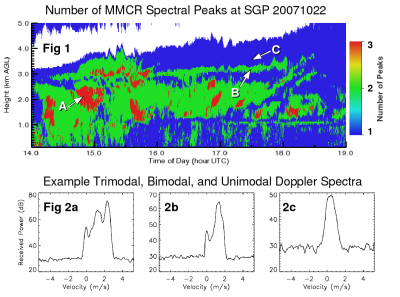Upgrades to Cloud Radar Lead to New Data Product: MicroARSCL
Published: 2 June 2009

By providing detailed information about cloud properties, the millimeter wave cloud radar (MMCR) is a key capability at ARM sites. Between 2004 and 2006, ARM completed upgrades to the digital portion of the MMCR receivers. These upgrades significantly improved the radar’s temporal resolution, extended the interval for detecting velocity, and allowed continuous recording of Doppler spectra. Using these improved measurements, researchers developed a new evaluation tool called the Microphysical Active Remote Sensing of Clouds (MicroARSCL). This tool automatically packages into an efficient summary the important characteristics of the Doppler spectrum and more accurate identification of radar clutter. A MicroARSCL data set for the period from May 2007 through May 2008 at the ARM Southern Great Plains site is currently available at the ARM Data Archive.
The need for the MMCR upgrade was established through a series of evaluations of processing performance with respect to the range of cloud conditions encountered at the ARM sites. Implementation of these improvements enabled the recording of full Doppler spectra. New methods of post-processing spectra, such as those applied by MicroARSCL, will aid in the extraction of cloud property information such as turbulence and microphysics. Additional ARM sites and time periods will be added to the MicroARSCL data set in the future.
These data (and more) are freely available in the ARM Data Archive. The first time you visit the Archive you will need to create a new account—a relatively short form asking for contact information—you can use right away. Order MicroARSCL data now.
The ARM Climate Research Facility is a DOE Office of Science user facility. The ARM Facility is operated by nine DOE national laboratories, including .
Keep up with the Atmospheric Observer
Updates on ARM news, events, and opportunities delivered to your inbox
ARM User Profile
ARM welcomes users from all institutions and nations. A free ARM user account is needed to access ARM data.


















